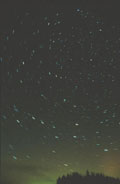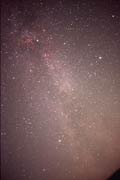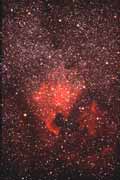|
 |
The
m
Cephei region; 180mm lens at f/2.5, 10m exposure. |
|
 |
Perseus double cluster (h and
c
Per) region; 180mm lens at f/2.5, 10m exposure. |
|
 |
Region around
l Orionis (head of
Orion); 180mm lens at f/2.5, 10m exposure. |
|
 |
Orion's Belt and sword
displaying the Orion Nebula, M43, Flame Nebula, Horsehead Nebula and
M78; 180mm lens at f/2.5, 10m exposure. |
|
 |
The Great Galaxy in Andromeda
and its two satellite galaxies; 10 min exposure onto Fuji Provia 400F
slide film through a 300mm f/2.8 lens. Camera mounted on a
Sky-Watcher EQ6. |
|
 |
The Pinwheel Galaxy, M33, in
Triangulum; 10 min exposure onto Fuji Provia 400F slide film through a
300mm f/2.8 lens. Camera mounted on a Sky-Watcher EQ6. |
|

|
Star trails around the North
Celestial Pole; 10 min exposure taken during a weak auroral display near Doune,
Scotland. A one hour exposure taken from
Sinai Desert in Egypt and a 15 minute exposure
taken in Scotland with a statue in the foreground. |
|
 |
Cassiopeia imaged over La Palma; 5 minute exposure on 200ASA Kodak Elitechrome through 58mm lens at f/2.
The familiar "W" is almost lost in the blaze of stars.
Here is an annotated image. |
|
 |
Auriga imaged over La Palma; 5 minute exposure on 200ASA Kodak Elitechrome through 58mm lens at
f/2. Capella is upper left and Saturn lower right.
Here is an annotated image. |
|
 |
Orion
trailed with a local monument in the foreground and also as a backdrop for trees. |
|
 |
The Milky Way stretching from Auriga to Puppis. A wide
angle view using a 16mm lens at f/2.8; 10 minute exposure onto Kodak Elitechrome 200 film. |
|
 |
A wide angle view of the Milky Way stretching from
Cygnus to Gemini. 10 minute exposure onto
Kodak Elitechrome 200 using a 16mm lens at f/2.8. |
|
 |
The Summer Triangle. Centred on
Altair, Vega and Deneb this view shows
the Milky Way from Aquila through to Cygnus. The Cygnus Rift and Star Cloud are
well-depicted as well as the emission nebulosities, the Nth American
Nebula and the region around g
Cygni. Ten minute exposure onto 200ASA slide film
using 28mm lens at f/1.8. |
|
 |
The North American Nebula in Cygnus,
NGC7000, photographed on the 20th Sept 2003 through a 300mm f/2.8 lens; 10 min
unguided exposure onto Elitechrome 200. Camera mounted on an EQ6. The Pelican Nebula is visible to the lower
right. |
|
 |
The region around
g
Cygni contains a wealth of emission nebulosity. 10 min unguided exposure
through a 300mm f/2.8 lens onto Elitechrome 200. Camera mounted on an
EQ6. |
|
 |
An image of the California Nebula,
photographed through a 300mm f/2.8 lens; 10 min unguided exposure on an
EQ6. |
|
 |
Orion Region taken on La Palma; Sirius is on the left of frame, Taurus
on the right; 20 minute exposure through a 28mm lens at f/1.8; 200ASA Kodak
Elitechrome. Here is a close-up of
Orion and an annotated
version. |
|

|
The
Pleiades. Also known as the "Seven Sisters" or M45, this is a young star
cluster containing several hundred stars. Image by eyepiece projection from my 15cm f/4 reflector into a Nikon CoolPix 4500 digital camera; stars
recorded down to 10th magnitude! |
|

|
The Pleiades imaged through a 300mm
f/2.8 lens; 10 min unguided exposure onto Elitechrome 200. Camera mounted on an EQ6. The
reflection nebulosity is nicely captured. |

















